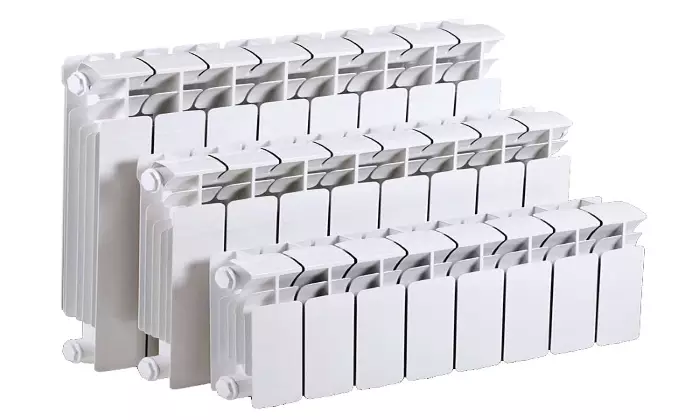
The actual question of the heating of premises has always demanded adoption of suspended solutions. Work on the installation of a high-quality heating system is very expensive, as the estimate includes not only the work of specialists, but also the equipment itself - pipes, radiators and boiler equipment.
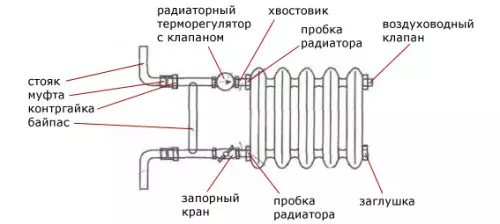
Scheme of the structure of the heating radiator.
Below is a comparative analysis of the heating devices commercially available. Having studied all the technical characteristics, it will be possible to save both precious time to choose and money for the purchase of this technique (with incorrectly accepted solution, additional funds are spent).
There are many varieties of heating radiators. To select the desired type of equipment, it is necessary to learn the technical characteristics of those, positive and negative sides.
Steel radiators (panel). Characteristic
Similar heating devices are called convectors. A pair of steel plates bonded with each other with welding, forms cavity for the coolant. The calculation of heat transfer of steel batteries is made by an area of such and does not depend on the number of sections from which it consists. When calculating, an approximate value of 4 kW per 1 sq.m. The area of the device, for example, the steel heating device with parameters 500 × 500 mm will produce approximately 1 kW. If more accurate data is required, the heat transfer table for certain types of batteries is used, which can be obtained from the supplier of this equipment, while the technical nuances of the heating system are taken into account.
Benefits of panel batteries:
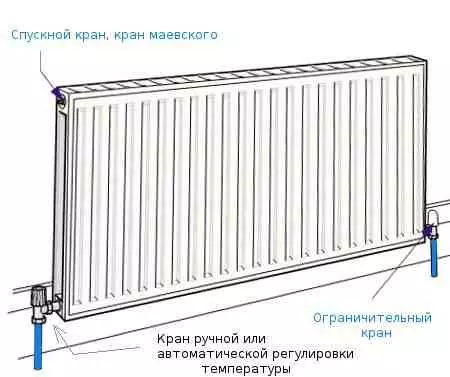
Connection diagram of steel radiator.
- High heat transfer.
- A large number of sizes (the probability of selecting the required amount of heat transfer).
- Not the highest price.
- Great design.
These advantages make steel radiators popular among potential consumers. Panel heating devices function perfectly in autonomous building heating systems.
Disadvantages of panel radiators:
- Low operating pressure.
- Great sensitivity to hydrouds (as a result - bloating and breaking the heating device).
- Prolonged location of batteries without water.
Article on the topic: How to assemble a coffee table with your own hands
These shortcomings do not allow the use of steel batteries in central heating systems.
Cast iron radiators
The most common type of batteries in high-rise buildings from Soviet times.
Benefits :
- Working pressure is quite high - up to 10 bar.
- Low susceptibility to pollution and aggressive impacts.
- High heat capacity.
- Practically not subject to corrosion.
- High strength.
Disadvantages :
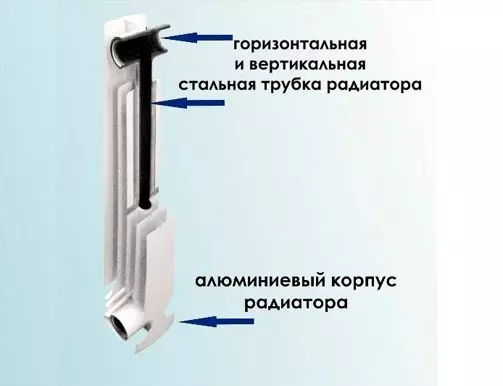
Diagram of the device of a bimetallic radiator.
- A large mass (as a result - the complexity of installation).
- High heat inertia (as a result - the inability to quickly adjust the desired temperature).
- Not very modern design (as a result, the need for regular painting).
- A small surface area gives a small percentage of convection (20%) from the total amount of the heat.
- These heating devices have a rough coating (as a result - accumulation of dust).
- Casting radiators bring damage to the hydrowards.
The heat transfer parameters of cast-iron batteries - from 100 to 200 W on the same section, there is a dependence on sizes of sections. The necessary information on the heat transfer of cast-iron batteries is from the supplier of this equipment. When calculating the heat transfer sections of the radiator, the temperature of the coolant is taken into account within 90 degrees, but during the central heating system, this temperature is not supported.
Steel radiators (tubular)
Benefits:
- Large selection of designer solutions.
- Operating pressure within 10 bar (as a result - use in central heating systems).
- The surface is covered with an anti-corrosion layer.
- In one section of the heat transfer fluctuates within 80-120 W.
Disadvantages:
- The wall thickness is a maximum of 1.5 mm (as a result - the briefness).
- Battery sections are not collapsible and have an exceptionally defined amount - 2, 6, 8, 12, 14, 16 sections.
Aluminum heating devices
Types of aluminum batteries:
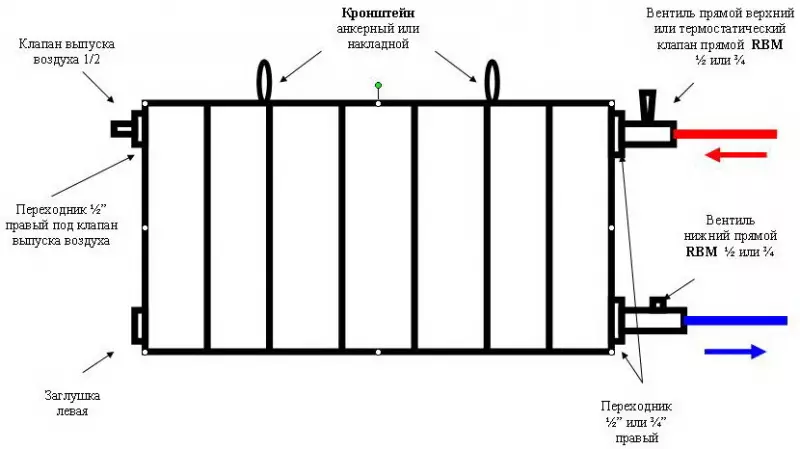
Aluminum radiator mounting scheme.
- Alloyed - every selection of solo.
- Extrusion - Each section is three elements that are tightly connected or mechanically, or with special bolts.
Article on the topic: How to implement the restoration of the table with your own hands?
Advantages of aluminum batteries:
- High heat transfer (from one section of 100-200 W).
- Have different types of designer solutions and aesthetic appearance, as they are made using casting.
- It is well adjustable heat due to a small amount of heat carrier inside the heating device and a large thermal conductivity.
- Have a small weight and easily installed.
- Operating pressure within 6-16 bar.
Disadvantages:
- The hydroedar can destroy aluminum heating devices (as a result - is not the best option for central heating systems).
- Characterized by sensitivity to increased acidity, which is inherent in the chemical composition of the coolant.
- In aluminum batteries, there is a gas formation effect (as a result, the recent system of heating).
Bimetallic radiators
This type of heating devices is considered the most optimal in design.
The advantages of bimetallic radiators. Main characteristics:
- Steel pipe strength and excellent thermal conductivity of aluminum - the coolant goes along steel pipes, and the temperature rise is discharged by aluminum ribs.
- The amount of water in the section is the lowest, if you compare with other types of similar equipment - within 150 ml (as a result - high efficiency).
- Possess all the positive qualities of steel and aluminum batteries.
- Since steel pipes completely exclude aluminum contact with a coolant, then there is no gas formation.
- The strength of the structures (as a result - operating pressure up to 30 bar).
- Aluminum gives bimetallic heating devices excellent design and provides good thermal conductivity.
- Well suited for mounting in central and autonomous heating systems.
Bimetallic batteries have only one drawback - quite high cost.
To make a final decision, what radiators acquire, all the characteristics of the equipment should be taken into account, make a list of requirements for acquired heating devices and only after that buy the necessary radiators for premises requiring heating.
